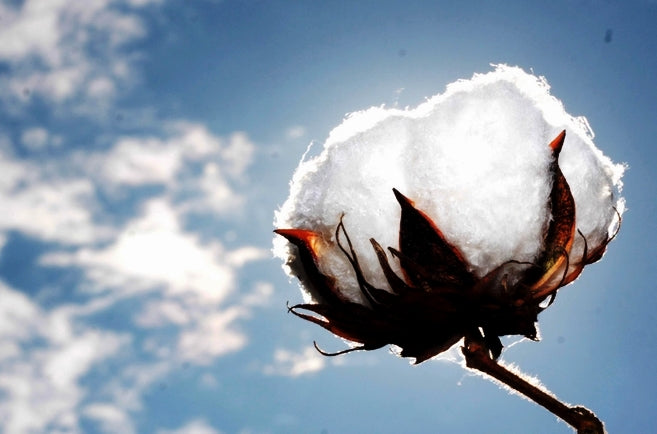The cotton plant is obtained from the genus Gossypium, which is from which cotton is derived. Cotton is a staple fiber, which means it is made of varying lengths of fibers.
Cotton is a soft and fluffy material made mainly from cellulose, an insoluble organic compound. Cotton plants need lots of sunlight, long periods without frost, and plenty of rain.
The term “cotton” refers to the white fluffy cotton fibers inside the boll—the encasing for the cotton plant. A cotton yarn is spun into a soft, durable fabric that is then woven.

Originally, the word cotton derives from the Arabic word “quton.”
The earliest known cotton production occurred in India around the 5th millennium of the common era.
The earliest production of cotton was in India, where the material dates back to the fifth millennium B.C.
It was in India in the thirteenth century that the original cotton gin was invented, which is a machine that separates cotton's fluff from plant seeds. As a result of the cotton gin, the production of cotton became more efficient and a more widely-used fabric.
In the Industrial Revolution, Britain became one of the leading cotton producers as new technologies like spinning jenny, spinning frame, and spinning mule were invented. Manufacturers were able to spin cotton at greater rates with all of these spinning machines.
It was, however, the invention of the mechanical cotton gin by the American Eli Whitney which helped lead to increased cotton production in the United States and Europe. This new tool, which separated cotton seeds from cotton plants using machine power, reduced the number of hours required to produce a bale by 600 hours to just 12. Around the same time, American cotton farmers, particularly in the southern states, began producing better quality cotton that was longer and stronger yarn.
Where is cotton grown?
Around the world, cotton is cultivated in nearly every tropical and subtropical region, in the Turkey, US, China, India, Uzbekistan, Pakistan and Brazil.
Turkey's Aegean region is famous for the world's best cotton harvest. The quality of cotton grown is markedly different from other regions in the world where cotton is grown, as the climatic conditions of the region shape it. This type of cotton unique to the Aegean region has made it's name known to the world as Turkish cotton.
In addition, Turkish cotton is the only cotton
in the world that produced without the use of GMO additives.

How is cotton processed?
Cotton production involves a lot of work, from sowing seeds to picking cotton crops to processing them in a cotton gin.
In the early days, cotton was picked and separated manually, but today most cotton production starts with a cotton picker, which picks the entire plant, or a cotton stripper, which rips the boll off the plant.
Before the cotton is sent to the gins, it's baled and stored in the fields before being ginned.
The cotton bales are cleaned by the gins to remove dirt, seeds, and lint.
Once the raw cotton has gone through the gins and separated completely from its seeds, the raw cotton is compressed and stored, ready to be shipped to textile mills for further production.

After the cotton has been cleaned and fluffed, it is passed through a carding machine, which then cleans the fibers into an untwisted thread, ready for spinning and weaving by skilled hands.
IVY LUXURY BATH ESSENTIALS

